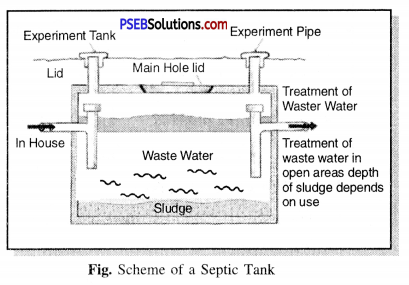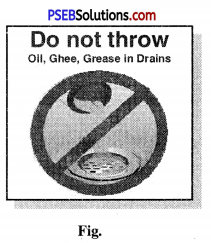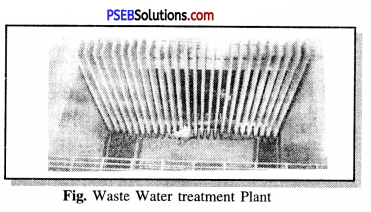Punjab State Board PSEB 7th Class Science Book Solutions Chapter 18 Wastewater Story Textbook Exercise Questions and Answers.
PSEB Solutions for Class 7 Science Chapter 18 Wastewater Story
Science Guide for Class 7 PSEB Wastewater Story Intext Questions and Answers
Think and Answer (Textbook Page No. 224)
Question 1.
What is the difference in colour of contaminated and clean water ?
Answer:
Clear water is colourless, but it may contain soluble impurities and microorganisms. This water is not pure and not drinkable.
Contaminated water in which microorganisms are present can also be colourless. Also, if there is any pigment or impurities in the water, it may be dark brown in colour.
Question 2.
Name any two organic contaminants present in drain water.
Answer:
Organic pollutants present in the drain waste water are:
-
- Insecticides,
- Diuretics,
- Fruits and vegetables waste,
- Human and animal excreta.
Think and Answer (Textbook Page No. 225)
Question 1.
Why are manholes builts in sewage route ?
Answer:
Manholes are made at every 50-60 m distance of the sewerage system or at the junction of two sewage discharges, so that the person can enter the sewage drain to identify and diagnose the problem.
![]()
Question 2.
Name any two organisms living in and around an open drain.
Answer:
- Cockroach and
- scorpion.
Think and Answer (Textbook Page No. 228)
Question 1.
What change do in you notice in the appearance of liquid after aeration ?
Answer:
The color of the liquid is slightly clear and light.
Question 2.
What was removed by the sand filter ?
Answer:
Insoluble solid particles were separated by sand filter.
PSEB 7th Class Science Guide Wastewater Story Textbook Questions and Answers
1. Fill in the Blanks:
(i) ……………….. are dissolved and suspended solid impurities present in sewage.
Answer:
Pollutants
(ii) The activated sludge is about ……………….. water.
Answer:
97%
(iii) …………………. is the solid material settled at the bottom of water clarifier.
Answer:
Sludge
(iv) ……………… is the place where contaminants are removed from wastewater.
Answer:
Water purification tank
![]()
(v) Adopt ……………….. sanitation practices.
Answer:
Good
2. State True or False:
(i) The sight and smell of open drain is attractive.
Answer:
False
(ii) Throw plastic bags in the drain.
Answer:
False
(iii) Open drain is the breeding place for flies and mosquitoes.
Answer:
True
(iv) Do not defecate in the open.
Answer:
True
(v) Solid food remains can block the drains.
Answer:
True
3. Match the Column ‘A’ with Column ‘B’:
| Column ‘A’ | Column ‘B’ |
| (i) Organic impurities | (a) Sewage treatment |
| (ii) Inorganic impurities | (b) Typhoid |
| (iii) Wastewater treatment | (c) Manure |
| (iv) Water borne diseases | (d) Nitrate and phosphates |
| (v) Dried sludge | (e) Human wastes |
Answer:
| Column ‘A’ | Column ‘B’ |
| (i) Organic impurities | (e) Human wastes |
| (ii) Inorganic impurities | (d) Nitrate and phosphates |
| (iii) Wastewater treatment | (a) Sewage treatment |
| (iv) Water borne diseases | (b) Typhoid |
| (v) Dried sludge | (c) Manure |
![]()
4. Choose the Correct Answer
Question (i)
Wastewater treatment plant involve:
(a) Bar screen
(b) Water clarifier
(c) Grit and sand removal tank
(d) All of these.
Answer:
(d) All of these.
Question (ii)
Name the by-product of wastewater treatment plant:
(a) Biogas.
(b) Sludge
(c) Both (a) and (b)
(d) None of these.
Answer:
(c) Both (a) and (b).
Question (iii)
Which of the following chemicals is used to disinfect water ?
(a) Chlorine
(b) Ozone
(c) Both (a) and (b)
(d) None of these.
Answer:
(c) Both (a) and (b).
Question (iv)
World Toilet Day is celebrated every year on:
(a) 29 November
(b) 19 October
(c) 19 November
(d) 29 October.
Answer:
(c) 19 November.
Question (v)
Which of the following is not a low cost onsite sewage disposal system
(a) Septic tank
(b) Compost pit
(c) Chemical toilets
(d) Bar screen.
Answer:
(d) Bar screen.
5. Very Short Answer Type Questions:
Question (i)
What is sewage ?
Answer:
Sewage.
This is the dirty water which contains soluble impurities dissolved and insoluble suspended impurities. It is produced by homes, offices, industries, farms and hospitals.
![]()
Question (ii)
What is Sludge ?
Answer:
Sludge.
The solid that settles at the bottom of a water purification tank is called Sludge.
![]()
Question (iii)
What is clarified water ?
Answer:
Clarified Water (Pure water).
It is colourless, odourless and tasteless water with pH value 7. Rainwater is pure water. The boiling point of pure water is 100°C. Pure water does not contain soluble or hanging impurities in it.
Question (iv)
What is septic tank ?
Answer:

Septic Tank.
This is a low cost onsite sewage treatment system that contains anaerobic bacterial enivironment to decompose the waste products. It has connection to main sewage discharge pipes. This is used in which excreta from the toilet passes through the covered pipes from the toilets directly to the biogas plant.
Question (v)
What is waste water treatment plant ?
Answer:
Waste Water Treatment Plant.
Polluted water of houses through covered underground Pipes is taken to sewage removing contaminants.
The water is taken to the treatment plant and after the treatment this water is discharged into the rivers or oceans. The remaining waste water is sent to the place where the impurities are separated from it. Separation of contaminants from waste, water is called water purification. Water treatment involves physical, chemical and biological processes which remove contaminants from the waste water. Waste water treatment plant is also called sewage treatment plant.
6. Short Answer Type Questions:
Question (i)
Why oil and fats should not be thrown in the drain ?
Answer:

Oil, ghee etc. should not be thrown in the drain, instead leftover should be put in the dustbin.
Because they harden and block the drainage pipes. If thrown in the open then they can close pores iin the soil which may reduce the ability of the soil to filter water.
Question (ii)
What is the function of bar screens in a wastewater treatment plants ?
Answer:
Function of Bar screen in waste water treatment Plants:

In waste water treatment plant at first this water which contains solid insoluble impurities such as cans, pieces of nepkins and plastic etc is first passed through a mesh having bar screens where these impurities are stopped and separated.
![]()
Question (iii)
“Throw litter in the dustbin only
Answer:
Always throw the garbage in the dustbin because scattering the garbage will not only pollute our surroundings but will also pollute the environment and give off a foul smell which will help in producing germs, insects and cockroaches. It will also cause many diseases. So throw litter only in the dustbin.
Question (iv)
What are the alternative arrangements for sewage disposal ?
Answer:
Alternative arrangements for sewage disposal.
Where there is no sewerage system, low cost sewage disposal systems such as septic tanks, chemical tanks, composting pits etc. can be constructed. A septic tank is a small sewage treatment system that contains anaerobic bacterial environment that separate waste pollutants. It has no connection with main sewage disposal pipes.
Question (v)
Why is it harmful to discharge untreated sewage in water bodies ?
Answer:
Untreated sewage contains inorganic and suspended contaminants. If this untreated sewage is discharged directly into water bodies then contaminants like germs present in it will get activated which will cause diseases like cholera, typhoid, diarrhoea, polio and hepatitis.
7. Long Answer Type Questions:
Question (i)
Write a brief note on open defecation.
Answer:
Open defecation.
Open defecation on railway tracks, banks of rivers or in the fields can cause health problems. It spreads many deadly diseases like cholera, typhoid, diarrhoea, polio and hepatitis.
About one lakh people die every year due to open defecation. In areas where open defecation is common, human feces and animal feces are swallowed by children accumulating large amounts of bacteria, parasites, and viruses in their bodies which causes diseases, even it leads to death.
Question (ii)
What steps will you take at home for efficient working of sewerage system ?
Answer:
Steps for efficient sewrage system at home. We should develop the following good habits for efficient sewerage system at the home.
- Don’t waste water. Every time you go to toilet and you flush the toilet, water runs unnecessarily. So manage the amount of water to be used in toilets by putting a bottle filled with water or a brick in your flush tank which will maintain the water pressure and reduce the wastage of water.
- Avoid using the toilet as a waste basket.
- Install water-efficient toilets. Fix standard for reducing water consumption each time you flush.
- Use only phosphate-free soaps and detergents.
- Use washing machine only when you have full load of clothes.
- Do not throw solid materials like tea leaves, wool, plastic envelopes (polythene), sanitary towels, soft toys etc. in the drainage water as they may block the drain. As a result, oxygen does not flow freely and the decomposition process slows down.
- Do not throw substances like ghee, machine oil, grease, pesticides and other chemicals etc. in the drain as it can kill the water purifying microorganisms.
PSEB Solutions for Class 7 Science Wastewater Story Important Questions and Answers
1. Fill in the Blanks:
(i) Cleaning of water is a process of removing ………………….. .
Answer:
contaminants
(ii) Waste water released by houses is called ………………… .
Answer:
sewage
![]()
(iii) Dried ……………… is used as manure.
Answer:
sludge
(iv) Drains get blocked by ………………. and ……………. .
Answer:
cooking oil, fats
(v) An open space covered by a lid is a passage through which a person can enter and check the sewage system is called …………….. .
Answer:
Manhole
2. Match the Column ‘I’ with Column ‘II’:
| Column ‘I’ | Column ‘II’ |
| (i) Waste water treatment by-products | (a) November 19 |
| (ii) World Water Day | (b) Breeding area for mosquitoes and flies. |
| (iii) Open defecation | (c) Humus and bio gas |
| (iv) World Toilet Day | (d) March 22 |
Answer:
| Column ‘I’ | Column ‘II’ |
| (i) Waste water treatment by-products | (c) Humus and bio gas |
| (ii) World Water Day | (d) March 22 |
| (iii) Open defecation | (b) Breeding area for mosquitoes and flies. |
| (iv) World Toilet Day | (a) November 19 |
3. Choose the Correct Answer:
Question (i)
A network of small and large underground pipes:
(a) Sewage
(b) Humus
(c) Stool excretion
(d) None of these
Answer:
(a) Sewage.
Question (ii)
World Water Day is celebrated:
(a) March 22
(b) 22 February
(c) April 22
(d) 22 June
Answer:
(a) March 22.
Question (iii)
Which gas absorbs ultraviolet radiation ?
(a) Nitrogen
(b) Oxygen
(c) Ozone
(d) Hydrogen
Answer:
(c) Ozone.
Question (iv)
Contaminated water causes diseases:
(a) Jaundice
(b) Diarrhoea
(c) Cholera
(d) All of the above
Answer:
(d) All of the above.
![]()
Question (v)
Malaria can spread through:
(a) Open drains
(b) Taps
(c) Closed drains
(d) Water pipes
Answer:
(a) Open drains
State True or False:
(i) Untreated sewage should be disposed of in reservoirs.
Answer:
False
(ii) Residual oil and ghee should be drained.
Answer:
False
(iii) Throwing polythene bags or pieces in the drains can choke the drain.
Answer:
True
(iv) Litter should be thrown in the dustbin only.
Answer:
True
(v) The solid settling at the bottom of a water purification tank is called sludge.
Answer:
True
Very Short Answer Type Questions
Question 1.
Which is World Water Day ?
Answer:
World Water Day : 22 March.
![]()
Question 2.
What is cleaning of water ?
Answer:
Cleaning of Water. Removing pollutants from waste water.
Question 3.
What is common name of waste water treatment ?
Answer:
Sewage Treatment.
Question 4.
How is Sewage formed ?
Answer:
Sewage. It is waste water discharged by homes, industries, hospitals, offices and other users.
Question 5.
Which organisms cause dysentery ?
Answer:
Microbes.
Question 6.
What is sewerage ?
Answer:
Sewerage. Network of small and big pipes called sewers form sewerage.
Question 7.
Which chemicals destroy water micro-organisms?
Answer:
Paints, painkillers, oils, medicines, etc destroy micro-organisms.
Question 8.
Why should solid waste not be dumped in drains?
Answer:
Because they pollute the drains and block the free flow of oxygen.
![]()
Question 9.
How does oxygen purify waste water?
Answer:
Oxygen helps in biodegradation.
Question 10.
Write the names of two causes for spread of diseases.
Answer:
Unhygienic surroundings and Polluted water.
Question 11.
Name the plant used at places where sewerage system is not available.
Answer:
Septic tank.
Short Answer Type Questions
Question 1.
Give a short account of alternative arrangements for sewage disposal.
Answer:
The alternative arrangements for sewage disposal are septic tanks, chemical toilets, compositing pits, etc.
All these are low cost onsite sewage disposal systems and are suitable for places where there is no sewerage systems. For example, in hospitals, isolated building or a cluster of 4-5 houses in a remote area.
Question 2.
Name some practices used at home which can minimise the waste production.
Answer:
Practices used at home to minimise waste.
- Greasy, oily things should not be dumped into drains, as they block (choke) the drains.
- Chemicals, paints, insecticides etc. should not be thrown into drains as they kill microbes that help to purify water.
- Solid wastes, used tea leaves, sanitary towels etc. should be thrown in dustbins and not in drains as they choke the drains.
Question 3.
What is Sewage ? Explain why it is harmful to discharge untreated sewage into rivers or seas.
Answer:
Sewage. Sewage is a liquid waste which has lot of dissolved and suspended pollutants in water. It is complex in nature.
It is produced in homes, industries, agricultural fields and in other human activities. It is main cause of water and soil pollution.
Harmful aspects of disposal of untreated water waste:
- It causes health hazards.
- Ground water and surface water gets polluted.
- It is carrier of water borne diseases.
Question 4.
Why should oil and fats be not released in the drain ? Explain.
Answer:
Oil and fats on hardening block the drain pipes. In open drains, the oils clog the soil particles reducing their power of filtering.
![]()
Question 5.
Describe the steps involving in getting clarified water from waste-water.
Answer:
Steps to get clarified water from waste water:
- Passing waste water through bar screening to remove large objects like rags, plastics, cans etc.
- Passing through grit and sand. Removal tank with slow speed to settle down sand and dust particles.
- Settling down of water is done in a big tank which has a slope in middle to remove faecal matter and floatable solids such as oils and grease. Water so obtained is called clarified water.
Question 6.
What is sludge ? Explain how it is treated.
Answer:
Sludge.
It is solid faecal matter collected from the waste water after passing through screen bars and grit and sand removal tank.
Treatment of Sludge.
It is collected in a tank to be treated by anaeroboic bacteria. The biogas produced is used for generating electricity. Dried sludge is used as a manure.
Question 7.
Untreated human excreta is a health hazard. Explain.
Answer:
Untreated human excreta.
- It is a breeding place for mosquitoes, flies and other insects.
- It is full of foul smell.
- It contaminates water and soil,
- It is carrier of many diseases.
Question 8.
Name two chemicals used to disinfect water.
Answer:
- Chlorine and
- Ozone.
Long Answer Type Question
Question 1.
Give a detailed account of waste water treatment plant.
Answer:
Waste water is contaminated with physical, chemical and biological pollutants. To remove all these physical, chemical and biological processes are to be involved.
(i) Bar-Screen treatment. Wastewater is allowed to pass through big bar screens to remove solid large objects such as napkins, tins, cans, sticks, plastics, etc.
(ii) Grit and sand removal tank. The wastewater is allowed to pass through these tanks at a very low speed so that sand, dust, and insoluble heavy particles settle down in these tanks.
(iii) Separating the sludge. In this process, water is put into a large tank whose middle portion is sloped. All solids get settled down and are removed with a scraper. This solid waste is known as sludge. Some floating solids are removed by a skimmer. Water, thus, obtained is called clarified water.
Now two separate processes are to be followed.
(a) Sludge is transferred to a tank to be decomposed by anaerobic bacteria when biogas is produced as a by-product.
(b) In the clarified water, aerobic bacterias are present to enhance their functioning. Air is pumped into the water. Bacteria consume the impurities left in water and settle down at the bottom. The water is then removed from the top. While the sludge settled at the bottom is dried and used as manure.
(iv) The above water is either discharged into sea or river to be naturally cleaned or treated with chlorine or ozone and supplied for further use.
